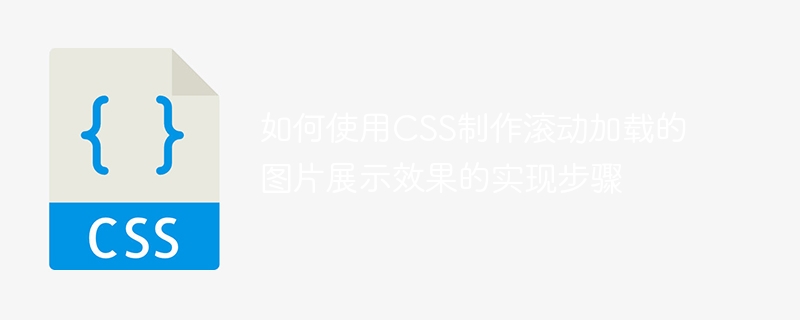

Steps on how to use CSS to create scrolling loading image display effects
With the development of web technology, scrolling loading has become a common way of displaying images. By using CSS, we can implement an image display effect with scrolling loading function, allowing the web page to automatically load new images while the user scrolls, improving the user experience.
The following will introduce a specific step to achieve the scrolling loading image display effect, and provide corresponding code examples.
Step 1: Create HTML structure
First, we need to create a basic HTML structure, including a packaging container and an image list.
<div class="container">
<ul class="image-list">
<li><img src="/static/imghw/default1.png" data-src="image1.jpg" class="lazy" alt="Image 1"></li>
<li><img src="/static/imghw/default1.png" data-src="image2.jpg" class="lazy" alt="Image 2"></li>
<li><img src="/static/imghw/default1.png" data-src="image3.jpg" class="lazy" alt="Image 3"></li>
<!-- 更多图片 -->
</ul>
</div>Step 2: Set CSS styles
Next, we need to set CSS styles for the container and image list so that they can adapt to the needs of scrolling loading.
.container {
height: 500px; /* 设置容器的高度 */
overflow-y: scroll; /* 设置垂直滚动 */
}
.image-list {
margin: 0;
padding: 0;
list-style: none;
}
.image-list li {
margin-bottom: 20px; /* 设置图片之间的间距 */
}Step 3: Use CSS pseudo-class to implement scrolling monitoring
In order to achieve the scrolling loading effect, we need to use CSS pseudo-class :after to listen for scrolling events.
.container:after {
content: "";
display: block;
height: 200px; /* 设置伪类的高度,用于触发滚动加载 */
visibility: hidden;
}Step 4: Use JavaScript to load images
Since rolling loading involves the actual loading of images, we need to use JavaScript to load images.
// 监听滚动事件
document.querySelector(".container").addEventListener("scroll", function() {
var container = this;
// 判断是否到达滚动加载的位置
if (container.scrollHeight - container.scrollTop === container.clientHeight) {
// 加载新的图片
var imageList = document.querySelector(".image-list");
var li = document.createElement("li");
var img = document.createElement("img");
img.src = "new_image.jpg";
img.alt = "New Image";
li.appendChild(img);
imageList.appendChild(li);
}
});The above code will dynamically add a new image when the user scrolls to the bottom of the page.
To sum up, through the above steps, we can use CSS and JavaScript to achieve a scrolling loading image display effect. By dynamically loading new images, we can improve the loading speed and user experience of web pages.
The above is the detailed content of How to use CSS to create scrolling loading image display effect implementation steps. For more information, please follow other related articles on the PHP Chinese website!